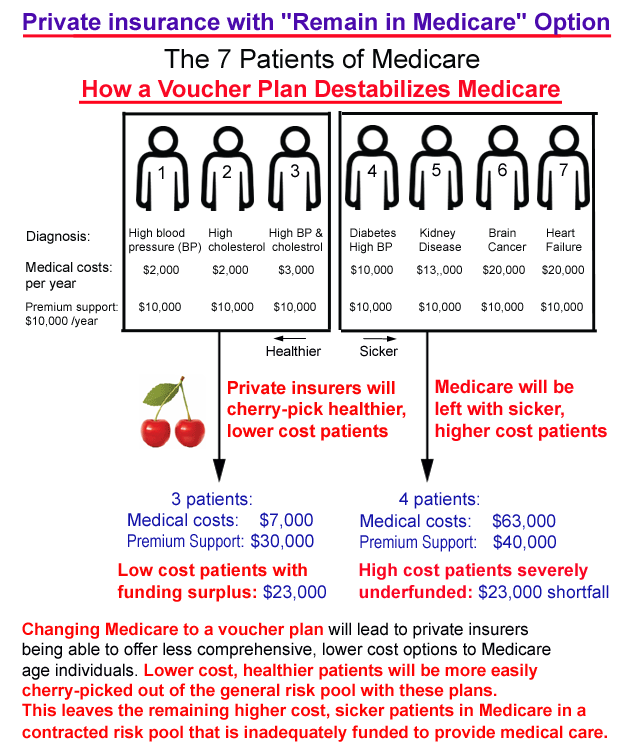![]()
A Voucher Plan for Medicare Will Worsen Care of Sicker Patients
Eric Roehm, M.D. March 2017
The voucher plan proposed by Paul Ryan to replace the current Medicare system represents a significant downgrade in Medicare’s commitment to seniors. Medicare currently has had a commitment to provide medical coverage to seniors. Ryan’s premium support proposal changes this commitment to one of providing assistance in obtaining medical coverage, not a guarantee of full coverage.
In Ryan’s system, a Medicare participant would get a voucher (premium support) from the government to help pay for insurance. Paul Ryan’s voucher (premium support) program will work similar to a school voucher program where the payment on behalf of a student is made directly to a school. In Ryan’s premium support program, the payment on behalf of the patient will be made directly to the insurer. The payment will be adjusted for age and income of the participant. (Presumably, there will be some adjustment for the severity of the illness of the participant.)
A stated goal of the Ryan proposal is to offer more variability in levels and types of benefits to participants when they choose their plans. Unfortunately, the more variability in the plans, the easier it is for the private insurers to cherry-pick the lower cost healthier patients and avoid the higher cost sicker patients.
The lower cost healthier participants, however, are crucial for providing funding for sicker more expensive patients in Medicare. For the purpose of illustration, consider the following example: the spending for the average participant in Medicare for hospital costs, doctor fees, diagnostic tests and several other services is approximately $10,000 per person. However, there are many healthy low cost Medicare participants that only have $2,000 per year of medical expenses. The $8,000 difference between actual expenses and average expenses is used towards the care of the sicker more costly patients in the current Medicare program. This benefits everyone, because even a healthy patient may sometime in the future become seriously ill or have a loved one who becomes seriously ill.
Any situation that allows private insurers the opportunity to more effectively cherry-pick the lower cost healthier patients out of the system leaves the sicker patients inadequately funded. The more flexibility and variability in the plans offered to the participants, the greater the opportunity for private insurers to selectively enroll healthier patients. Even with the lower degree of plan variability present in existing Medicare Advantage plans (Medicare plans are run by private insurers, usually through managed care), there is cherry-picking of lower cost patients. More options, particularly plans with “leaner” benefits, will make cherry-picking of healthier lower cost patients easier. Private insurers will follow the financial incentives to optimize their risk pool of patients. They will seek to attract lower cost patients and avoid enrolling higher cost patients. They will also have plan benefits and services constructed in such a way that the sicker, more costly patients are more likely to withdraw from their plans.
A voucher plan will not be able to accurately adjust the dollar amount of the premium support to correspond to the high medical expenses of seriously ill patients initially enrolling in the Medicare program. Take a patient with chronic congestive heart failure with a history of two hospitalizations per year and monthly doctor visits whose medical expenses can easily average $40,000-50,000 per year. At the time of initial enrollment into Medicare, how will a premium support payment fully reflect the cost of caring for this patient? There is not a good mechanism. And a simple adjustment of the premium support by age does not reflect the 20-fold difference in medical expenses that can be present even for patients of the same age.
The private insurers will understandably avoid this type of inadequately funded patient like the plague. The terms of their insurance plans will quite naturally be constructed to be very unfavorable to this type of patient. This $40,000-50,000 of medical expenses per year patient will more likely end up in traditional fee-for-service Medicare (The Ryan plan initially includes traditional Medicare as one of the options for care.) Regardless of which plan these high cost patients ultimately enroll in, the plan in which they do enroll will be significantly underfunded to provide medical care for these sicker patients.
Medicare Advantage plans (private insurer run Medicare plans) are held out as the standard to aspire to in Ryan’s plan description. However, Medicare Advantage plans have cost Medicare hundreds of billions of dollars more than traditional Medicare to insure similar patients. Even today, with the payment reductions made to Medicare Advantage plans, Medicare Advantage plans continue to cost more for the care of a similar patient compared to traditional Medicare.
In summary, a voucher plan using premium support will result in the care of the higher cost sicker patient to be underfunded. The greater variability in the insurance plans that will be offered in a premium support program will enhance the current ability of private insurers to cherry-pick healthy patients and avoid the higher cost sicker patients. The Medicare Advantage plans, which Ryan lauds as being optimal examples of cost efficient care, actually are still more expensive for the Medicare program than care of a similar patient in traditional Medicare. (Medicare Advantage plans are a worthwhile option for Medicare participants, but they have not to date been found to be more cost effective.)
Figure 1 illustrates the effects of cherry-picking the healthier lower cost patients from the general insurance pool when a “Remain in Medicare” option is available to current Medicare participants . The care of the sicker patients is left substantially underfunded. Though there will be some adjustment of the dollar amount of premium support for the individual patient, the costs of the much sicker patients will be inadequately represented in this adjustment. The sicker patients will be underfunded in terms of the premium support and the healthier patients will be overfunded. Cherry-picking will selectively enroll the healthiest patients, leaving the remaining sicker patients in a risk pool that is underfunded.
Figure 1:
Figure 2 illustrates a voucher system in which only private insurance is offered to Medicare age patients. The prior “7 Patients of Medicare” will have essentially the same outcome as in the first example. Private insurers will selectively cherry pick the lower cost, healthy patients with lower cost policies or benefits geared to this set of patients. The sicker patients will be left in a risk pool that is insufficiently funded to provide adequate care.
Figure 2:
A voucher system will increase the ability of private insurance companies to cherry-pick the healthier beneficiaries by allowing greater variability in the coverage options they are allowed to offer. Since everyone of Medicare age will eventually either personally develop a significant illness in the future or have a loved one who does, an inadequately funded risk pool for sicker patients is a concern for us all.
www.NutritionHeart.com/Medicare-at-Risk

